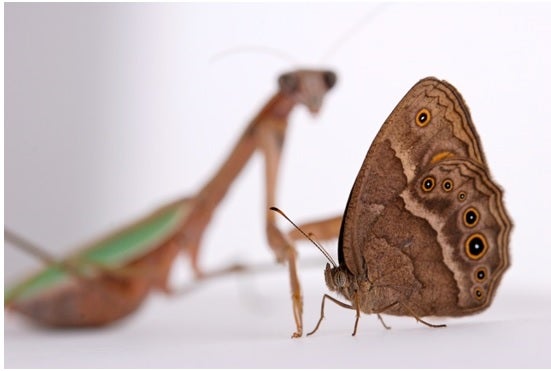Butterflies develop different sized eyespots
Antónia MONTEIRO (Group Leader, Biological Sciences) () March 15, 201515 Mar 2015 Praying mantises preferentially attack the eyespot patterns on the wings of butterflies instead of their bodies, contributing to the evolution of eyespot size plasticity.
Many organisms adapt to fluctuating environments, such as the different annual seasons, by changing their appearance. This ability is called phenotypic plasticity. Bicyclus anynana butterflies change the size of their eyespots depending on whether they emerge in the wet or in the dry season in Africa. Small eyespots were previously shown to be adaptive to dry season butterflies, making them inconspicuous to bird predators; however, it was unclear why the butterflies developed large eyespots in the wet season.
A team led by postdoctoral fellow Kathleen PRUDIC and Prof Antónia MONTEIRO from the Department of Biological Sciences in NUS showed that praying mantises, predominantly found during the wet season, may be responsible for the evolution of larger eyespots in wet season butterflies. A series of lab experiments showed that mantis fatally attack dry season forms targeting the head and thorax, while they target the large eyespots of wet season forms often leading to prey escape. Large eyespots, thus, may have evolved to help wet season butterflies escape these large insect predators (see Figure).
This study focuses attention on the role of insect predators, instead of the traditional focus on avian predators, in shaping the evolution of butterfly wing patterns. The study also highlights that different predator guilds across wet and dry seasons contribute to the evolution of phenotypic plasticity of their prey species.

Tenodera sinensis mantid observing a wet season Bicyclus anynana butterfly (Image credit: Piotr NASKRECKI)
Reference
Prudic KL, Stoehr AM, Wasik BW, Monteiro A. “Invertebrate predators attack eyespots and promote the evolution of phenotypic plasticity”. Proc R Soc B 282 (2015) 20141531.


